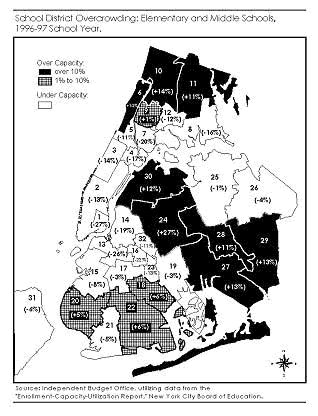
click pic to see larger version
Originally published in Issue 13 - September 1, 1997
Introduction
Each fall, the opening of public schools in New York City is met with a host of expectations and concerns on the part of students, parents, elected officials, and other interested members of the community. To highlight some of the challenges facing the New York City Board of Education (BOE) in the upcoming 1997-98 school year, IBO has prepared this special edition of Inside the Budget. Topics selected for review include school overcrowding, City and State funding of BOE initiatives, the hiring of new teachers, and the status of an assortment of other BOE initiatives. These topics have all been the object of IBO’s attention at various points over the course of the past year, and will be monitored during the months ahead. If you have questions on any of the items discussed below, please call our office at (212) 442-0632 or access our website for additional information.
Surge In Enrollment Straining Classroom Capacity
Public school overcrowding has been a recurring challenge in New York City over the last several years, and is expected to remain so during the upcoming 1997-98 school year, as a result of continued growth in enrollment. Total enrollment growth, fueled in large part by the arrival in the City of large numbers of immigrants, has averaged nearly 20,000 students per year since 1991. With the number of students attending the City’s public schools during the upcoming school year expected to climb by another 18,000, is expected to increase system-wide enrollment to about 1,094,000. By the turn of the century, total enrollment is projected to increase by yet another 32,000 students.
The graphic below, prepared by IBO using data from the 1996-97 school year on elementary and middle school enrollment, presents a geographic look at the degree of overcrowding in each community school district in the City. The variation is in large part reflective of the fact that new immigrants to the City in recent years have tended to gravitate more to certain neighborhoods than to others, with community school districts in northern Manhattan, as well as southern and western Queens, facing the greatest degree of overcrowding. The designation of “Over Capacity” in the accompanying graphic indicates districts in which aggregate enrollment in district schools exceeds total classroom capacity. Conversely, the designation of “Under Capacity” indicates districts in which aggregate enrollment in district schools is less than or equal to total classroom capacity.
In response to the challenge of school overcrowding, BOE has begun to implement a number of space enhancing initiatives, including building or leasing of new space, the introduction of Transportable Classroom Units (TCUs) into the playgrounds of overcrowded schools, modular additions to existing school buildings, and the development of plans to keep schools open year-round.
With respect to the TCU initiative, each unit contains two air-conditioned classrooms and bathroom facilities and is suitable for occupancy by up to 60 students. The BOE’s most recent plans call for providing seats for a total of 9,000 students over the next three years through the utilization of TCUs. Concerning the longer term, BOE plans to decrease the use of TCUs and instead move to increased reliance on modular additions to existing school buildings. If BOE approves its updated capital plan, some 31,960 children will be housed in modular additions as of the 1999-2000 school year.
With respect to year-round schooling, BOE plans to begin piloting the program in buildings with air conditioning during the 1998-1999 school year, pending the required approval of such plans by the State legislature. Assuming such approval is granted, year-round schooling will be expanded to other school buildings once they are retrofitted for air conditioning.
